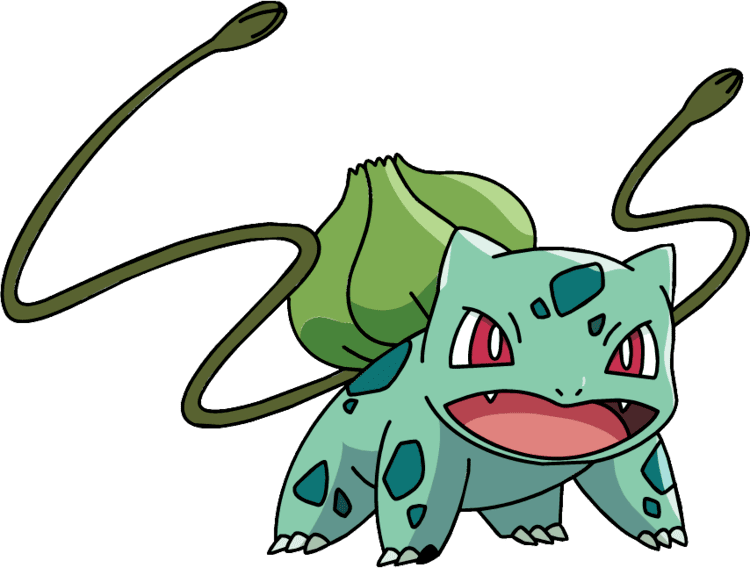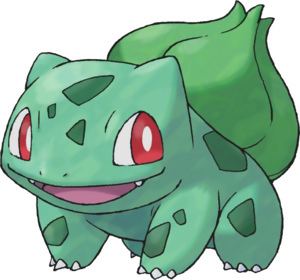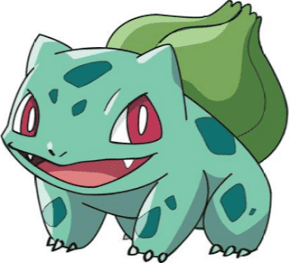First game Pokémon Red and Blue Category Seed Ability Overgrow Height 71.1 cm | Type Grass, Poison Evolves to Ivysaur | |
 | ||
Weakness Ice, Flying, Psychic, Fire Similar | ||
Bulbasaur (/ˈbʌlbəˌsɔːr/), known as Fushigidane (フシギダネ) in Japan, is the first Pokémon species in Nintendo and Game Freak's Pokémon franchise. Designed by Ken Sugimori, their name is a combination of the words "bulb" and "dinosaur." First appearing in Pokémon Red and Green as a Starter Pokémon, they later appeared in subsequent sequels, spin-off games, related merchandise, and animated and printed adaptations of the franchise.
Contents
- Conception and design
- Characteristics
- In the video games
- In the anime
- In other media
- Promotion and merchandising
- Reception and legacy
- References

Known as the Seed Pokémon, Bulbasaur can survive for days solely on sunlight. It is a central character in the anime, being one of Ash's main Pokémon for the first season, and a different one later being obtained by May. It is featured in various manga, and is owned by protagonist Red in the Pokémon Adventures manga. Bulbasaur has been featured in myriad pieces of merchandise, including toys, key chains, and plush dolls.

Conception and design

The design and art direction for Bulbasaur was provided by Ken Sugimori, a friend of the creator of the Pokémon games, Satoshi Tajiri. The species first appeared as one of three starter Pokémon the player could choose from at the beginning of the initial Game Boy games, Pokémon Red and Blue, released in Japan in 1996. Its Japanese name, Fushigidane, is a combination of the Japanese words for mystery or miracle (fushigi) and seed (tane). In translating the game for English speaking audiences, Nintendo gave the Pokémon "cleverly descriptive names" related to their appearance or features as a means to make the characters more relatable to American children; thus Bulbasaur, relating to both its dinosaur appearance and the large garlic-shaped bulb on its back. The idea to feature Bulbasaur and the other Red and Green starters in a significant role in Pokémon X and Y came about a year and a half into the development of the games. The Mega Evolutions for the three Pokémon's final forms were created, and the designers decided that they should give players an opportunity to receive one of these Pokémon from Professor Sycamore, the games professor, to see their Mega Evolved form.
Characteristics
In the Pokémon franchise, Bulbasaur are small, squat reptilian and frog Pokémon that move on all four legs, and have light blue-green bodies with darker blue-green spots. As a Bulbasaur undergoes evolution into Ivysaur and then later into Venusaur, the bulb on its back blossoms into a large flower. The seed on a Bulbasaur's back is planted at birth and then sprouts and grows larger as the Bulbasaur grows. The bulb absorbs sunlight which makes it grow. For this reason, Bulbasaur enjoy soaking up the sun's rays, and can survive for days without eating because the bulb stores energy. The distinctive differences of Bulbasaur from other Pokémon such as Diglett are well understood by children and so motivate their play and trading of the creature.
In the video games
Bulbasaur made its video game debut on February 27, 1996, in the Japanese-language games Pocket Monsters Red and Green. Along with Charmander and Squirtle, Bulbasaur is a starter Pokémon the player can choose from at the beginning of the games. Bulbasaur's Grass type is in contrast to Charmander's Fire type and Squirtle's Water type. Bulbasaur and the other starters from Red and Blue are replaced by Pikachu in Pokémon Yellow, the only starter available in it. Instead, they are obtained throughout the game from several trainers. In Pokémon FireRed and LeafGreen, remakes of Red and Green, Bulbasaur is selectable as a starter Pokémon once again, along with Charmander and Squirtle. In Pokémon HeartGold and SoulSilver, after obtaining all sixteen badges and defeating Red, the player can choose to obtain either Bulbasaur, Charmander, or Squirtle. In Pokémon X and Y, players can also choose between Bulbasaur, Charmander, and Squirtle near the start of the game shortly after having chosen the games' new starter Pokémon.
The Nintendo 64 spin-off Pokémon Stadium, and other spin-offs such as Pokémon Mystery Dungeon, give the player a choice of a Bulbasaur (among fifteen other Pokémon), and in Pokémon Snap, Bulbasaur are one of the Pokémon that the player can photograph. It also appears in Pokémon Puzzle League as one of Ash's Pokémon. Bulbasaur also appears in Hey You, Pikachu! as a supporting character who lives in the Ochre Woods and makes the five recipes with Pikachu's help. In Super Smash Bros. Melee and Brawl, Bulbasaur appears as one of the obtainable trophies. Bulbasaur appears in PokéPark Wii: Pikachu's Adventure as the host of a mini-game called "Daring Dash".
In 2016, Bulbasaur was one of the three starter Pokémon in Pokémon Go.
In the anime
Scenes from the Pokémon anime have depicted both the characters Ash and May training a Bulbasaur at different times, with Ash's Bulbasaur garnering more prominence within the storylines. Ash’s Bulbasaur has remained with Ash longer than all of his other Pokémon, with the exception of his Pikachu. Before joining Ash's team, it lives with a girl named Melanie, who takes care of abandoned Pokémon. Bulbasaur is given to Ash, but it is pessimistic about him. However, its loyalties begin to improve and it eventually becomes one of Ash's most faithful Pokémon. May catches a Bulbasaur while traveling in a grass-type Pokémon nature reserve during her journey in Hoenn. Bulbasaur defends her from the other grass Pokémon in the forest, who see her as a threat, and when May leaves, Bulbasaur decides to go with her. She later makes a guest appearance on the series and it is revealed that her Bulbasaur has fully evolved into a Venusaur.
In the original Japanese version the two Bulbasaur are each played by separate voice actresses, Ash's Bulbasaur by Megumi Hayashibara and May's by Miyako Itō. In the English dub, they are both voiced by Tara Jayne until Michele Knotz took over the job for the ninth season.
In other media
Bulbasaur is featured in an eclectic range of different Pokémon manga series. In Pokémon: Pikachu Shocks Back, Electric Pikachu Boogaloo, and Surf’s Up, Pikachu!, which loosely parallel the storyline of the anime, Pikachu is separated from Ash temporarily, and travels with a Bulbasaur to a secret Pokémon village in the mountains. Later, Ash finds Pikachu and catches the Bulbasaur. Bulbasaur accompanies Ash throughout his journeys in the Orange Islands, and eventually fights in the final showdown with Drake, the Orange Crew Supreme Gym Leader. In Magical Pokémon Journey, a character named Pistachio has a female Bulbasaur (nicknamed Danerina in the Japanese version), who is infatuated by him.
In Pokémon Adventures, a manga based on the plot of the Pokémon Red and Blue games, the character Red receives a Bulbasaur from Professor Oak, which he nicknames Saur. In Chapter 15, "Wartortle Wars", it evolves into an Ivysaur after battling a wild Mankey.
Bulbasaur is the main character of two Pokémon children's books, Pokémon Tales Volume 3: Bulbasaur’s Trouble and Bulbasaur’s Bad Day, published in 1999 and 2000 respectively by Sagebrush. In Pokémon Tales Volume 3: Bulbasaur’s Trouble, Bulbasaur resolves an argument between two other Pokémon. In Bulbasaur’s Bad Day, Meowth traps Bulbasaur in a pit and it has to outwit Team Rocket (the antagonists of the Pokémon anime) to escape.
Promotion and merchandising
Bulbasaur has been featured in varying pieces of merchandise, including toys and plush dolls. Bulbasaur has been depicted in action figures sold by Hasbro in the United States, while Tomy in Japan sold extensive merchandise of the character, including vinyl dolls, wind-up model kits, and terry cloth bean bags. It has also been used in promotional merchandising at fast-food chains such as McDonald's and Burger King. Bulbasaur has also been included in various versions of the Pokémon painting on ANA Boeing 767s. The island nation of Niue issued a commemorative coin with a legal tender value of one crown which has a Bulbasaur on the reverse side.
Reception and legacy
IGN named Bulbasaur the "52nd best" Pokémon. IGN author Audrey Drake noted that she had a "very special attachment" to it due to it being her first Pokémon. She also stated that it may be her "favorite". Game Informer also included it in its list of the best Pokémon at #3 (along with Charmander and Squirtle). Author O'Dell Harmon noted the choice between these three Pokémon as the "most important" one in the series' history. Game Revolution called Bulbasaur the "best Pokémon ever". Author Alex Osborn stated that it "embodies the charm that makes Pokémon what it is" and called it his "personal favourite". Fellow Game Revolution editor Daniel Bischoff noted it as his "favourite Pokémon" as well. Nintendo World Report's Pedro Hernandez also called it his "favourite" Pokémon. He noted that it "represented" a number of "firsts" for him - including his "first episode" of the Pokémon anime, his "first Pokémon", and the "first Pokémon" he "saw in 3D." He also attributes Bulbasaur to the reason he became interested in the Pokémon series. Official Nintendo Magazine's John Vekinis attributed his "love of Grass-type Pokémon" to Bulbasaur in spite of the Grass type's weaknesses. Official Nintendo Magazine readers voted Bulbasaur as the "second best" Grass-type Pokémon. Author Thomas East noted that it "looked better" than his later forms. Their readers also named it the "best" starting Pokémon. GamesTM called it the "best starting Pokémon" for Red and Blue. CNN reporter Dennis Michael described Bulbasaur as one of the "lead critters" of the games and "perhaps the Carmen Miranda" of Pokémon figures. Bulbasaur was selected as one of the top ten Pokémon by fans who voted at Pokemon.com. In an IGN biography page, Bulbasaur is described as "the odd man out" in the Pokémon Red and Blue game because it represented neither color, thought added "it’s perhaps the best-known grass-type Pokémon, even though it’s a little bit more animal than vegetable", as well as noting its popularity with new players of the games. IGN editor "Pokémon of the Day Chick" agreed, despite the fact its later evolutions were "slightly eclipsed by Charizard", and also praised the anime incarnation for its attitude. GamesRadar editor Brett Elston described Bulbasaur as being "popular" for more than just being the first Pokémon numerically, citing its moveset and evolutions. Fellow GamesRadar editor Carolyn Gudmundson, in an article on the "top 7 gut-wrenching choices", listed the choice between fire, grass, or water with Bulbasaur as a "frontrunner", due to being a dinosaur as well as being grass type, though found its later evolutions "ugly and charmless".
According to a panel of five-to-eight-year-olds assembled by the Honolulu Star-Bulletin in 1999, Bulbasaur was one of the children's "three favorite Pokémon". One boy in a study by Dafna Lemish and Linda Renee-Bloch identified with Bulbasaur's attributes of being "strong and also cute". Lemish and Renee-Bloch feel that the importance of cuteness is an example of the "appropriation of Japanese values" in an Israeli context, and note that boys' desire for strength has been correlated with "a desire for social interaction".
Bulbasaur was among eleven Pokémon chosen as Japan's mascots in the 2014 FIFA World Cup.
